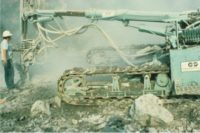January 31, 2014
The Honorable David Michaels
Assistant Secretary
Occupational Safety and Health Administration
U. S. Department of Labor
200 Constitution Avenue, NW
Washington, DC 20210
RE: ASSE Comment on the OSHA Proposed Rule Occupational Exposure to Crystalline Silica (Docket No. OSHA-2010-0034)
Dear Assistant Secretary Michaels:
The American Society of Safety Engineers (ASSE) is pleased to submit the following comments concerning the Occupational Safety and Health Administration’s (OSHA) Proposed Rule Occupational Exposure to Crystalline Silica published in the September 12, 2013, Federal Register (78 Fed. Reg. 56273). This is an issue that will significantly impact the ability of workers to return home from work each day healthy, of employers to be able to reasonably carry out their business without unnecessary burdens, and of safety, health and environmental (SH&E) professionals to be able effectively to assist both in achieving effective protections from crystalline silica risks.
As you know, ASSE is the oldest and largest society of safety professionals in the world. Founded in 1911, ASSE represents over 35,000 dedicated safety, health, and environmental (SHE) professionals. Our members are experts in managing workplace safety and health issues in every industry, in every state and across the globe. They belong to one or more of ASSE's 20 practice specialties, many of which will be affected by this rulemaking. ASSE is also the Secretariat for various voluntary consensus standards related to best practices in occupational safety and health, including the Z10 standard for Safety and Health Management Systems.
Silica dangers known since the time of the ancient Greeks
ASSE commends OSHA for addressing this issue through rulemaking in an effort to further reduce the incidences of occupational illnesses such as silicosis and cancer in general industry, maritime and construction work. While some may debate the science underlying the findings set forth in the proposed rule, overexposure to crystalline silica has been linked to occupational illness since the time of the ancient Greeks, and reduction of the current permissible exposure limit (PEL) to that recommended for years by the National Institute for Occupational Safety and Health (NIOSH) is long overdue. In 2011, ASSE formally requested to the Office of Management and Budget's Office of Information and Regulatory Affairs (OIRA) that it release the pending silica proposal for public comment so that all stakeholders could participate in the discussion about appropriate rulemaking, including safety and health professionals who are already working with employers to protect workers from silica risks in cost-effective, practicable ways.
In short, requiring implementation of feasible engineering and administrative controls, improved medical surveillance and proactive exposure monitoring in situations where exposures above the PEL can be anticipated is a reasonable approach and is generally consistent with the recommended best practices established in the ASTM E1132 Standard Practice for Health Requirements Relating to Occupational Exposure to Respirable Crystalline Silica, (general industry) and the ASTM E2625 Standard Practice for Controlling Occupational Exposure to Respirable Crystalline Silica for Construction and Demolition Activities.
ASSE supports the goals
ASSE supports the goals for this rulemaking and will remain involved throughout the hearing and post-hearing period when further technical comments may be offered. In this, our initial submission, ASSE provides specific comments that we urge OSHA to take into consideration in drafting a final rule. The agency has posed nearly ninety questions for commenters to consider, and many of these are beyond the scope of ASSE’s ability to respond because they seek site-specific information and data that only can be provided by individual employers or employee representatives.
Similarly, although OSHA has provided a great deal of scientific and epidemiological information on the potential health effects of overexposure to crystalline silica, we will not be commenting at this time on the validity of these studies. While commenters on both sides will no doubt argue about which studies should be given more or less weight, it is indisputable that overexposure to respirable crystalline silica presents risks of silicosis. In 1997, the International Agency for Research on Cancer (IARC) classified silica as a Group One human carcinogen. Despite ongoing emphasis inspection programs conducted by OSHA since that time, and education of workers through the hazard Communication Standard (29 CFR 1910.1200), employees are still being diagnosed with silica-related occupational illnesses and overexposures to the current 100 µg/m3 limit continue to occur with disturbing frequency. More is needed to protect the health of our nation's workers.
Two million workers covered
The proposed rule would lower the PEL to 50 micrograms per cubic meter of air (µg/m3), which is 50% of the current PEL and consistent with the NIOSH REL. OSHA has also proposed an action level of 25 µg/m3, which is consistent with the Threshold Limit Value (TLV) set by the American Conference of Governmental Industrial Hygienists (ACGIH). The proposed rule covers the three forms of crystalline silica – quartz, cristobalite, and tridymite – and applies to general industry, maritime, and construction. According to the OSHA proposed rule, the final rule would affect over 2 million workers, and the agency’s risk assessment links overexposure to respirable crystalline silica to health conditions that include lung cancer, silicosis, chronic obstructive pulmonary disease, and autoimmune disorders.
What the rule would require
The proposed rule not only aims to enforce significantly lowered action and permissible exposure levels (PEL) but also places on operators increased requirements for administrative and engineering controls as well as exposure monitoring, medical surveillance, and implementation of “best practices.” A key issue surrounds currently utilized sampling methods, which may not have precision down to the 25 µg/m3 action level – the level that triggers many of the rule’s requirements – but OSHA indicated that the standard is intended to be “technology forcing.” We support OSHA's position of providing some lead time for laboratories to obtain necessary accreditation. Doing so will help ensure the accuracy of the sampling and analysis of silica samples that will be used to benchmark compliance and trigger some of the rule’s requirements. A failure in this area could leave the rule susceptible to legal challenge and could result in further delays in worker protections.
Under the proposed standard for general industry, employers must perform initial monitoring of employees “who are, or may reasonably be expected to be” exposed to crystalline silica at or above the action level of 25 µg/m3. For those general industry operators already testing for crystalline silica exposure, the previous testing may suffice for the proposed initial monitoring proposed above, and we agree with this approach. The requirement for initial monitoring is satisfied if the employer has monitored employee exposures in the twelve months before the standard’s effective date or has “objective data” that demonstrates that respirable silica “is not capable of being released at or above the action level under any expected conditions of processing, use or handling.” “Objective data” is defined as “monitoring data from industry-wide surveys or calculations based on the composition or chemical or physical properties of a substance.”
However, where the initial monitoring shows that exposure is above the action level but below the PEL, the monitoring must be repeated every six months. If the initial monitoring shows exposures above the PEL, repeat monitoring must be done every three months until two consecutive tests show exposure below the action level. Additional assessments are required “whenever a change in the production, process, control equipment, personnel, or work practices may reasonably be expected to result in new or additional exposures at or above the action level.” This is a reasonable approach, consistent with sound industrial hygiene practices.
Alternative approach for construction industry
The proposal for construction provides for a similar assessment of employee exposure but provides an alternative approach – “task based control strategies” – for certain operations that ASSE believes should similarly be allowed in general industry. For these operations, the employer, instead of assessing employee exposure, may implement specified equipment safeguards and work practices. If the equipment and work practices are implemented, the employer is not required to assess employee exposure. ASSE urges OSHA to consider taking a similar approach, perhaps in a non-mandatory appendix, for common job classifications in general industry and maritime that are known to have historically high silica exposures so that smaller employers can be guided as to what types of controls will be most efficacious.
In the proposal, OSHA proposes a hierarchy of mandating engineering and workplace controls over simply providing personal protective equipment (PPE) such as respirators, and it specifically bars job rotation as a method of attaining compliance. For tasks that involve some levels of silica exposure but are performed in an infrequent basis, job rotation may be warranted as an alternative to other, more burdensome, engineering or administrative controls. We urge OSHA to reconsider this issue, especially given the fact that every person on earth is exposed to some degree to crystalline silica as a main constituent of the planet's crust and due to its presence in so many construction materials. While ASSE appreciates the goal of limiting the number of employees exposed to toxic chemicals generally, crystalline silica provides a unique situation when compared to chemicals such as benzene and toluene.
The proposed rule states that “the employer shall use engineering and work practice controls to reduce and maintain employee exposure … to or below the PEL unless the employer can demonstrate that such controls are not feasible.” The employer is responsible for implementing the controls to reduce exposure to the “lowest feasible level” and supplementing with use of respiratory protection. In addition, both the general industry and construction standards require that, whenever an employee’s exposure “is or can reasonably expected to be in excess of the PEL,” the employer must establish either a “regulated area” or have a “written access control plan” to limit persons who may enter, and require certain protections (e.g., respirators, protective clothing or removal of dust from contaminated clothing) for any persons who do enter the restricted area. While ASSE generally supports this concept, there will be practical issues with implementation on small short-term construction worksites, and ASSE urges OSHA to take into consideration the comments of construction employers in determining how best to address this issue.
Medical monitoring requirements
OSHA has included in the proposed rule medical monitoring requirements for any worker exposed to heightened levels of crystalline silica. The proposed rule states that medical surveillance must be provided for each employee who will be exposed above the PEL for 30 days or more per year at no cost to the employee. The surveillance program includes an initial baseline exam within thirty days of initial assignment and repeat exams every three years or more frequently if recommended by a health care provider. ASSE supports this requirement but urges the agency to address in a final rule how this requirement addresses contingent workers who may move from one job to another, never staying for a full 30 days, but consistently having silica exposure.
The proposed rule stipulates requirements and provisions regarding laboratory testing and record keeping of exposure data. The proposed rule requires operators to retain accredited laboratories to analyze samples. Additionally, operators will also be required to maintain complete records and materials such as samples, reports, and medical surveillance records related to respirable crystalline silica exposure. This is appropriate, and exposure and surveillance data should be readily available to workers and, where applicable, to employee representatives. Records should be permitted to be stored electronically to ease paperwork burdens.
The rule’s preamble makes quite frequent reference to the American Society for Testing and Materials (ASTM) standards for general industry (E1132) and construction (E2625), which dictate best practices but do not include an occupational exposure level. It may be beneficial to incorporate by reference one or both of these consensus standards, consistent with the OMB Circular A119 and the Technology Transfer Act of 1995, or at least include relevant portions in OSHA guidance information.
To the specific questions OSHA poses in the Proposed Rule, ASSE provides the following comments:


